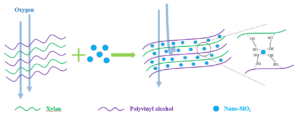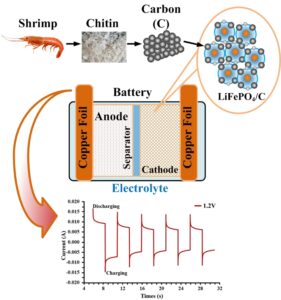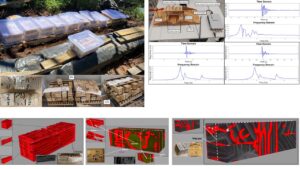Research Articles
Latest articles
- Researchpp 4168-4181Sagdic-Oztan, C., Koschella, A., Heinze, T., Karaguler, N. G., and Tuter, M. (2023). “Preparation of bacterial cellulose using enzymatic hydrolysate of olive pomace as carbon source,” BioResources 18(2), 4168-4181.AbstractArticlePDF
Bacterial cellulose has superior physical and chemical properties, biocompatibility, and purity. However, the high production cost obstructs the common use of this polymer. This study investigated the efficiency of olive pomace, an important by-product of olive oil industry in Turkey, as a carbon source for Novacetimonas hansenii. Olive pomace pretreatment with 1% H3PO4 was followed by enzymatic hydrolysis. The maximal reducing sugar concentration upon enzymatic process was 9.3 g/L with 1 enzyme: 6 substrate (dry matter) ratio. After incubation in the growth media prepared with the obtained reducing sugar as carbon source, the highest bacterial cellulose production was 0.68 g/L. Structural analysis indicated that bacterial cellulose from the enzymatic media and the conventional Hestrin-Schramm medium possess similar characteristics. The present work provides a favourable method to reduce the cost of bacterial cellulose production.
- Researchpp 4182-4194Xie, L., He, X., Hu, Y., Wei, X., and Shen, L. (2023). “Wooden cantilever covered bridges in Anhua, China,” BioResources 18(2), 4182-4194.AbstractArticlePDF
Wooden cantilever covered bridges are known for their marvelous shapes and manufacturing technique. Many wooden cantilever covered bridges were constructed during Ming and Qing Dynasties in Anhua province, China, due to the “Tea-Horse Trade” policy. The excellent performance of wooden materials and exquisite building techniques have kept these wooden bridges well-preserved and worthy of investigation. This paper conducted a comprehensive review of wooden cantilever covered bridges in Anhua, especially for the eight bridges listed as historical and cultural heritage protected at the provincial or the national level. The discussions covered the historical background of the bridges, their locations and dimensions, and the details of their structures including the cantilever systems, corridors, and roofs. Moreover, the cultural background was introduced to better understand the meaning of the decorations carved on the bridges and the logic of location selections.
- Researchpp 4195-4211Liu, G., Shi, K., Sun, H., Yang, B., and Weng, Y. (2023). “Nano-SiO2-modified xylan-PVOH-based composite films: Mechanical and barrier properties investigation,” BioResources 18(2), 4195-4211.AbstractArticlePDF

Hemicellulose from a wide range of sources and abundant reserves shows good biocompatibility, degradability, and renewability. Because of its low degree of polymerization and a large amount of hydroxyl groups, hemicellulose-based films exhibit low strength and tend to be hydrophilic, which hinders some potential applications. Therefore, hemicellulose-based films with improved strength and barrier properties are needed. In this study, nano-SiO2 was incorporated into polyvinyl alcohol/xylan matrix for the purpose of preparing an inorganic-organic hybrid composite film with elevated mechanical and barrier performance. The addition of nano-SiO2 can serve this purpose. A 1% nano-SiO2 loading resulted in an increase of contact angle of the composite film from 89.6° to 110.4°, an increase of the tensile strength from 11.2 to 14.8 MPa, and a decrease of oxygen permeability from 1.83 to 0.27 (cm3×µm)/(m2·d·kPa), which corresponds to a contact angle that was increased by 23%, tensile strength increased by 32%, and oxygen permeability decreased by 85%. These results indicated that the nano-SiO2 modified xylan film might have great application prospects as a barrier film in food packaging.
- Researchpp 4399-4412Ratchai, E., Luengchavanon, M., Techato, K., Limbuta, W., Chotikhun, A., and Voo, N. Y. (2023). “Characteristics of carbon from chitin-coated LiFePO4 and its performance for lithium ion battery,” BioResources 18(3), 4399-4412.AbstractArticlePDF

A LiFePO4 battery is the best device for energy storage. Batteries are currently being developed for higher capacity using novel materials. Carbon is one material that can be used to improve the properties of LiFePO4 batteries. The chitin produced from shrimp shell is a viable material that can be transformed into organic carbon. The chitin is revealed to be an element of 36.6 wt% carbon (C). Carbon is formed of small crystallites comprising electrode composite with a uniform carbon coating that can improve the electrochemical activation for LiFePO4/C composites. When the electrochemical reaction was operated at 1.2 V, the flow rate was increased 80%. The average charge-discharge capacities were 100 and -100 mAh/g, respectively, while the average energy density over a period of 20 cycles was 336 Wh/kg (maximum ~350 Wh/kg). Therefore, organic carbon can be used to remarkably improve the properties of LiFePO4 batteries with low-cost materials.
- Researchpp 4413-4429Jarawi, N., and Jusoh, I. (2023). “Charcoal properties of Malaysian bamboo charcoal carbonized at 750 °C,” BioResources 18(3), 4413-4429.AbstractArticlePDF
The carbonization of five Malaysian bamboo species, namely Bambusa vulgaris, Dendrocalamus asper, Gigantochloa hasskarliana, Gigantochloa levis, and Schizostachyum brachycladum, was conducted to investigate the charcoal properties and compare the quality of bamboo charcoal produced based on proximate analysis. Carbonization at 750 °C using a modified Iwasaki steel drum kiln was successful for all bamboo species. Bamboo morphological features varied and basic density increased with culm height. A charcoal yield of more than 30% was recorded in all bamboo species except for B. vulgaris and D. asper. Charcoals made from D. asper and G. hasskarliana could serve as the alternative raw material for charcoal production in charcoal industries due to their low moisture, low volatile matter, low ash, and high fixed carbon content. All species had a mean gross calorific value between 24.4 and 29.2 MJ/kg. Among different culm sections, the bottom section produced the best quality charcoal. The charcoal quality from all species was of acceptable quality for domestic use.
- Researchpp 4430-4449Shirmohammadi, M., Faircloth, A., Chan, K.-Y., and Fitzgerald, C. (2023). “Assessment of termite damage in cross-laminated timber sections using micro-computed tomography and vibration analysis,” BioResources 18(3), 4430-4449.AbstractArticlePDF

The durability of engineered wood products (EWPs) is a parameter yet to be fully investigated and understood. This is specifically important for mass timber structures and cross-laminated timber (CLT) panels. The effect of termites and scale of damage on radiata pine sawn boards have been previously investigated. However, the effects of glue line and the layered structure of CLT exposed to termite feeding in the field in Australia have not been studied. A total of 420 CLT specimens with different exposed faces and layer arrangements were exposed to termite attack in the field. Microcomputer tomography and vibration analysis were used to assess sample conditions before and after 20 weeks exposure. The observed changes showed damage patterns within samples where a glue line and different growth ring patterns were present. The termites created continuous damage along the longitudinal cells through the length and width of the samples. The 3D data showed that the edge gap on the face of panels could potentially act as a pathway for termites entering the core or mid-layers of the panel. The vibration frequency values were lower for samples after the termite exposure. The vibration analysis results showed significant effects of sample direction exposed to termite attack, and percentage of mass loss had significant effects on internal friction and damping values determined.
- Researchpp 4450-4457Toba, K., Nakai, T., and Murano, T. (2023). “Temporal changes in strain condition on all lateral surfaces during pretreatment before timber drying,” BioResources 18(3), 4450-4457.AbstractArticlePDF
Wood drying, such as boxed-heart square timber, often involves surface checks, which spoils the appearance of wood products and reduces their market value. Pretreatments are performed to avoid the surface checks, but detailed information about surface strain during timber drying remains unclear. In this study, surface strain detections were performed using two types of strain sensors (strain gauge and optical fiber strain sensor) to understand the surface dimensional changes during a series of pretreatments, consisting of steaming and high temperature and low humidity treatment. Simultaneous strain measurements based on the optical fiber sensor grasped the surface strain distributions in each lateral surface during timber drying; contraction behaviors were observed in the middle part of most surfaces in the early steaming stage, while one surface showed expansion. A remarkable expansion was detected in one surface during the high temperature and low humidity treatment, although most of the other surfaces showed gradual contraction behaviors. It was also discovered that the above detected behaviors were gradually reduced with the progress of each pretreatment.
- Researchpp 4458-4474Dygas, D., and Berłowska, J. (2023). “Sugar beet processing waste as a substrate for yeast protein production for livestock feed,” BioResources 18(3), 4458-4474.AbstractArticlePDF
This study investigated the optimal yeast strains for producing single cell protein based on waste sugar beet pulp (SBP) under various biomass loads. All tested strains were capable of growing on the waste biomass. Candida utilis and Saccharomyces cerevisiae Ethanol Red produced the greatest increase in protein on fresh SBP (ΔN 1.84%). Scheffersomyces stipitis (ΔN 2.27%) provided the highest increase on dried SBP. All tested strains showed significant assimilation of nitrogenous compounds. Based on the crude fiber content after fermentation, the largest reduction in fiber occurred with Candida utilis R6 (10.5%) on fresh SBP, and Yarrowia lipolytica (13.1%) on dried SBP. These results demonstrate the potential of SBP as a substrate for the production of single cell protein and highlight the importance of selecting the appropriate strains to optimize the process.
- Researchpp 4475-4491Karapınar, C., and Öz, M. (2023). “Chemical content of volatile oil of Primula veris subsp. columnae, obtaining the methanol extracts and their biological activities,” BioResources 18(3), 4475-4491.AbstractArticlePDF

The proportions and constituents of the essential oils of flowers and leaves of Primula veris subsp. columnae were determined, and the antioxidant and the antimicrobial (antibacterial and antifungal) properties of their methanol extracts were investigated. Percentage ratios and main components of the Primula veris subsp. columnae plant, which grows naturally, were detected by extracting flower and leaf volatile oils. The components of the volatile oil were identified with Gas Chromatography Mass Detector-Flame Ionization Detector (GC-MS/FID). A total of 62 compounds were identified in flower volatile oil, and methyl 4-methoxysalicylate (37.1%) was determined as the main compound. While defining the structure of 50 compounds in leaf essential oil, linoleic acid (40.1%) was established as the main compound. As the result of the extraction of flowers and leaves with methanol, the extractive substance was obtained as 34.5% in flowers and as 28.8% in leaves. Methanol extraction and the antioxidant properties of the Primula veris subsp. columnae plant were quite high. In the antifungal and antibacterial activity test conducted on the volatile oils and methanol extracts of flowers and leaves of the Primula veris subsp. columnae species, only flower volatile oil showed weak inhibition properties.
- Researchpp 4492-4509Rahman, M. R., Bin Othman, A.-K., Yurkin, Y., Burkov, A., Shestakova, U., Bin Bakri, M. K., Alfaifi, S. Y., Madkhali, O., Aljabri, M. D., and Rahman, M. M. (2023). “Rheological and mechanical study of micro-nano sized biocarbon-PLA biodegradable biocomposites,” BioResources 18(3), 4492-4509.AbstractArticlePDF
Pinewood sawdust was pyrolyzed to create a micro-nanocarbon. The adsorbent’s particle size was reduced during a ball milling procedure to improve the surface area and encourage porosity growth. The synergistic effects of micro-nano-adsorbent-reinforced poly(lactic acid) (PLA) composites were investigated by analyzing the efficiency of the rheological process. The properties of the prepared composites also were examined using various characterization tests, including tensile and hardness tests, crystallinity tests, elemental composition, and plasticity behavior tests. Therefore, in-depth investigations and comparisons were also carried out to confirm the created composites’ efficacy compared to other outcomes.
